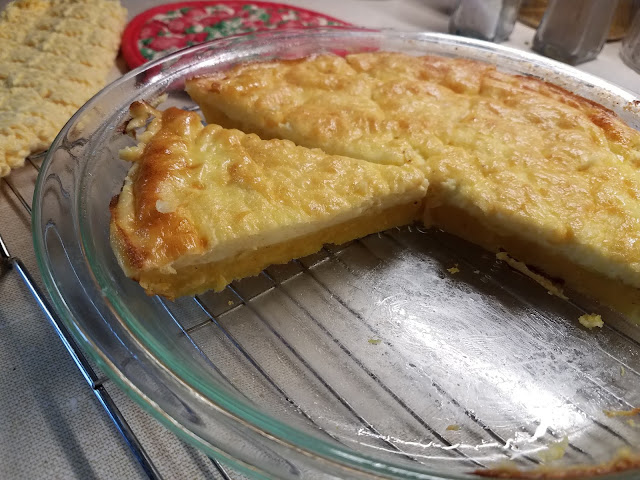Bannock
Printed in "the first cookbook compiled and published in Maine," this recipe comes to us thanks to the Ladies of State Street Parish in Portland, who compiled recipes for "Fish, Flesh and Fowl: A Book of Recipes for Cooking" in 1877.
Being such an old recipe, there are virtually no instructions, except to scald the milk, and allow it to cool before stirring in the eggs. It is mentioned as a flatbread. So I was puzzled by the proportion of eggs and milk to dry ingredients. I cut the recipe in half, and used 4 eggs and 2 cups milk, plus a full cup of cornmeal and a little sugar and salt. I chose to add 1 t baking powder, although that was not in the recipe.
All it says is to bake "in high oven." So I figured maybe I should treat it like I do a custard. I baked it at 450 for 15 minutes in a lightly greased glass pie dish, then dropped the heat to 350 for 30 minutes. The result was a thick polenta base with what amounts to scrambled eggs on top. And the fascinating thing is that the polenta, being so dense, did not allow the milk and eggs to penetrate, thus resulting in a complete separation of the two. You literally can lift the eggs off of the polenta in a clean separation.
Honestly, I couldn't decide if I wanted ketchup with my eggs, or butter with my polenta?!! I researched "Bannock" specific to Native American recipes, and found that most other recipes use water, no milk or eggs, and it is to be fried in a hot frying pan, in oil, not baked in an oven. This recipe tastes good, once you accept that there are really two food products. I added ketchup, salt and pepper, hot out of the oven, and this two-for-one breakfast was delicious!




Comments
Post a Comment
I welcome your comments. Please be kind and considerate. Thanks for stopping by!